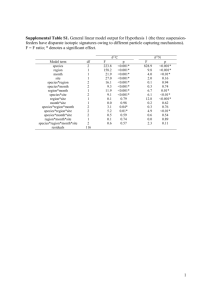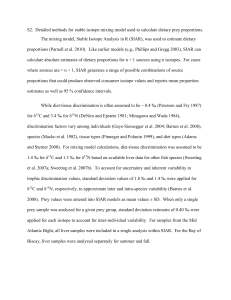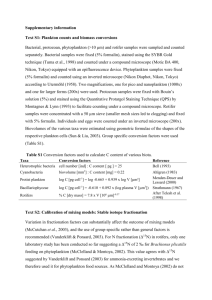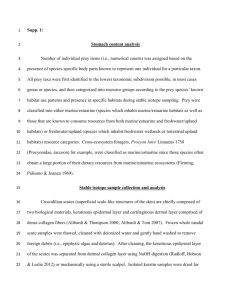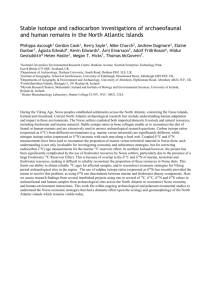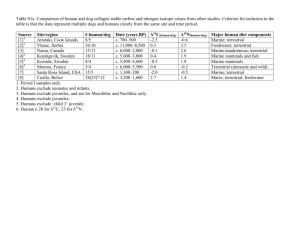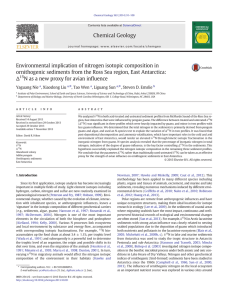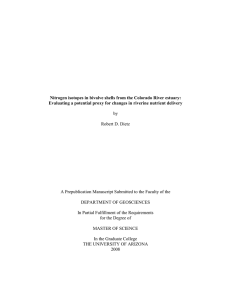gbc1854-sup-0002-txts01
advertisement
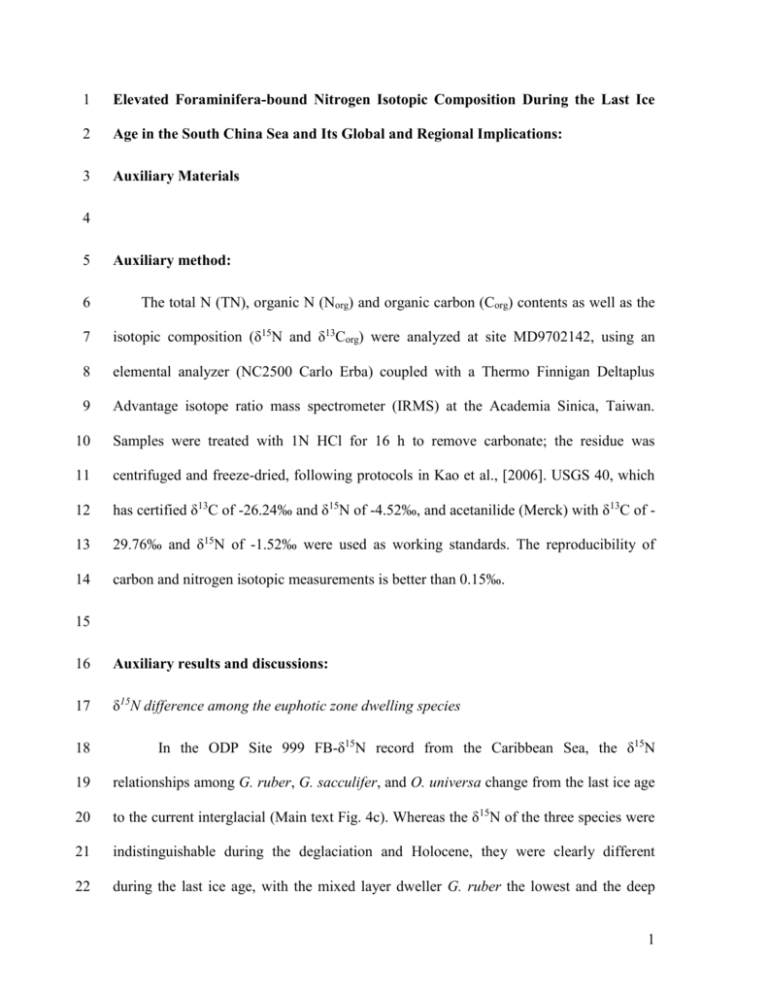
1 Elevated Foraminifera-bound Nitrogen Isotopic Composition During the Last Ice 2 Age in the South China Sea and Its Global and Regional Implications: 3 Auxiliary Materials 4 5 Auxiliary method: 6 The total N (TN), organic N (Norg) and organic carbon (Corg) contents as well as the 7 isotopic composition (δ15N and δ13Corg) were analyzed at site MD9702142, using an 8 elemental analyzer (NC2500 Carlo Erba) coupled with a Thermo Finnigan Deltaplus 9 Advantage isotope ratio mass spectrometer (IRMS) at the Academia Sinica, Taiwan. 10 Samples were treated with 1N HCl for 16 h to remove carbonate; the residue was 11 centrifuged and freeze-dried, following protocols in Kao et al., [2006]. USGS 40, which 12 has certified δ13C of -26.24‰ and δ15N of -4.52‰, and acetanilide (Merck) with δ13C of - 13 29.76‰ and δ15N of -1.52‰ were used as working standards. The reproducibility of 14 carbon and nitrogen isotopic measurements is better than 0.15‰. 15 16 Auxiliary results and discussions: 17 δ15N difference among the euphotic zone dwelling species 18 In the ODP Site 999 FB-δ15N record from the Caribbean Sea, the δ15N 19 relationships among G. ruber, G. sacculifer, and O. universa change from the last ice age 20 to the current interglacial (Main text Fig. 4c). Whereas the δ15N of the three species were 21 indistinguishable during the deglaciation and Holocene, they were clearly different 22 during the last ice age, with the mixed layer dweller G. ruber the lowest and the deep 1 23 chlorophyll maximum dweller O. universa the highest. This was interpreted as indicating 24 a change in the importance of N fixation relative to subsurface nitrate supply, with a 25 reduction in N fixation during the last ice age leading to a stronger vertical gradient in the 26 particulate N food source to foraminifera within the euphotic zone [Ren et al., 2009]. In 27 the SCS record, the δ15N difference among the three species is on average smaller during 28 the current interglacial than during the last ice age, and the maximal difference occurs at 29 the LGM (Fig. S2b), in the same sense as the data from the Caribbean. The similarity of 30 the three species in late Holocene sediment is consistent with the lack of depth gradient in 31 the δ15N of the suspended POM in the 50 m euphotic zone of the modern SCS [Loike et 32 al., 2007; Yang, unpublished data]. A similar interpretation for the LGM differences as 33 put forward for the Caribbean data would thus seem to apply to the SCS. 34 However, the SCS data show much smaller inter-species changes than observed in 35 the Caribbean LGM sediments; in particular, G. sacculifer and O. universa show no clear 36 δ15N difference throughout the SCS record. Even with the data smoothed (Fig. S2), the 37 evidence for a greater difference between G. ruber and the other species during the LGM 38 is subtle. Modern ocean studies are needed to truly address this question. Nevertheless, 39 we suspect that the more muted signal in the SCS derives from the depth compression of 40 features and the weaker stratification and less clear vertical structure within euphotic 41 zone of the central to northern SCS than in the Caribbean. In the SCS, upwelling and 42 other effects from the monsoons bring micromolar levels of nitrate to within 50 m of the 43 surface, such that the SCS lacks a nitracline and deep chlorophyll maximum that is 44 clearly segregated from the wind-mixed layer [Liu et al., 2002; Wong et al., 2002, 2007]. 45 It is thus very likely that the depths of maximum occurrence of the three euphotic zone- 2 46 dwelling foraminifera have always been much more similar than in the Caribbean, with a 47 parallel convergence in the biogeochemical conditions that they experience. If so, the 48 isotopic divergence of the euphotic zone species during the last ice age would be 49 expected to be weaker than in the Caribbean, as observed. 50 51 Bulk sedimentary measurements 52 Previously published bulk sedimentary δ15N records from the SCS show minimal 53 glacial/interglacial difference and were interpreted as evidence for a constant mean ocean 54 nitrate δ15N [Kienast, 2000]. However, our FB-δ15N record is drastically different from 55 the bulk sedimentary δ15N record at this site (Fig. S3) and from previous studies in SCS 56 [Higginson et al., 2003; Kienast, 2005], questioning the reliability of bulk sedimentary 57 δ15N in the SCS. The use of bulk sedimentary δ15N as a recorder of past changes in the 58 δ15N of N export may be compromised by contamination from terrestrial or shelf N input, 59 as well as by bacterially driven degradation, which can significantly elevate the δ15N of 60 sedimentary N relative to the N sinking out of the surface ocean [Altabet and Francois, 61 1994; Lourey et al., 2003]. The sharp rise in the bulk sedimentary δ15N near the coretop 62 at MD97-2142 is likely due to preferential loss of light nitrogen isotope during 63 degradations. Records of carbonate, organic carbon content, carbon to nitrogen ratio and 64 δ13C of the organic matter at MD97-2142 show long- and short-term variations that may 65 offer insights into the bulk sedimentary δ15N record and its differences from the FB-δ15N 66 record. 67 Consistent with previous studies at this and other sites in SCS, the glacial section 68 at MD97-2142 has lower carbonate and higher total organic carbon (TOC) content 3 69 relative to the current interglacial (Fig. S3a,b), which may be due to greater terrigenous 70 input during times of low sea-level stand [Chen et al., 2003; Shiau et al., 2008] as well as 71 higher productivity in the last ice age [Lowemark et al., 2009]. Although the δ13C record 72 suggests a marine origin for most of the TOC, higher C/N ratio during the last ice age 73 indicates a greater contribution of terrestrial inputs (Fig. S3c), which is also supported by 74 evidence of higher terrigenous organic biomarker concentrations during the last ice age in 75 the SCS [Pelejero, 2003]. Today, the bulk sedimentary δ15N of the nearest river 76 discharge, the Pasig River from the Luzon Island, is around 2 to 3 ‰, which significantly 77 lowers the δ15N of the surface sediment in the basin near the river [Gaye et al., 2009]. 78 Thus, we suspect that the glacial bulk sedimentary δ15N could have been lowered by 79 greater terrestrial inputs. 80 More relevant to FB-δ15N than bulk δ15N, TOC content shows an increase starting 81 at ~25 ka, which is possibly related to the early rise in FB-δ15N (Fig. S3). There appears 82 to be a deglacial input of terrigenous material (see decline in δ13C) that lowers TOC and 83 carbonate content. If these decreases in TOC were stripped from the records, then the 84 TOC record would show a broad maximum centered on roughly ~13 ka. This TOC 85 record has been interpreted as indicative of changing SCS productivity [Chen et al., 86 2003; Lowemark et al., 2009]. If so, this would be consistent with our suggestion that a 87 monsoon-driven shoaling of the thermocline occurred late in the last ice age and waned in 88 the mid-Holocene; we called upon this above as a possible explanation for the late glacial 89 increase in FB-δ15N and then the mid-to-late Holocene decrease in FB-δ15N, 90 superimposed on the deglacial ocean nitrate δ15N maximum and the glacial-to-interglacial 91 increase in N fixation (Main text Fig. 5). Above, we also noted an 8.3 ka maximum in 4 92 FB-δ15N that coincides with a faunal and G. ruber δ18O event, all of which could be 93 explained by a weakening of the thermocline, perhaps driven by stronger upwelling. We 94 note here that this 8.3 ka event overlaps with a sedimentological event (peaks in TOC and 95 carbonate) that is also consistent with a brief sharp shoaling of the SCS thermocline, in 96 that such a shoaling would increase productivity. However, we must recognize that this 97 view of the bulk sediment data is selective; for example, there is also an earlier 98 sedimentological event (at ~10.5 ka) for which there is no corresponding feature in the 99 FB-δ15N record. 100 101 Auxiliary figure captions: 102 Figure S1 103 Locations of the study site MD97-2142 (solid symbol, 12°41’N, 119°27’E, water depth 104 1557m), and two comparison sites from previous studies (open symbols), MD012404 105 from Okinawa Trough (26°39’N, 125°48’E, water depth 1397m, Kao et al., 2008), and 106 MD98-2181 from west equatorial Pacific (6°18’N, 125°49’E, water depth 2114m, 107 Kienast et al., 2008). 108 109 Figure S2 110 a) Three-point running average of foraminifera-bound δ15N. Blue: O. universa; Red: G. 111 sacculifer; Green: G. ruber. b) The difference between δ15N of G. ruber and the average 112 δ15N of G. sacculifer and O. universa. c) δ18O of G. ruber (white) calcite (‰ v. VPDB) 113 from Wei et al., 2003. 114 5 115 Figure S3 116 Relevant additional measurements from sediment core MD97-2142 from the South China 117 Sea. a) TOC content (black filled circles) in comparison with June insolation at 30°N 118 (blue curve, [Berger and Loutre, 1991]). b) Carbonate contents (red filled circles). c) 119 Atomic ratio of carbon and nitrogen (red open circles) and δ13C of organic matter (black 120 open circles). d) δ15N of bulk sedimentary nitrogen in black crosses. e. δ18O of G. ruber 121 (white) calcite (‰ v. VPDB) [Wei et al., 2003]. The purple arrows highlight two events 122 that appear to be characterized by colder, more vertically mixed conditions and higher 123 surface productivity in the SCS. The second of these events (but not the first) corresponds 124 to an FB-δ15N maximum for all three euphotic zone dwelling species (Main text Fig. 6). 125 126 Auxiliary references: 127 128 Altabet, M. A., and R. Francois (1994), Sedimentary nitrogen isotopic ratio as a recorder 129 130 131 for surface ocean nitrate utilization, Global Biogeochem. Cycles, 8(1), 103-116. Berger, A., and M.F. Loutre (1991), Insolation values for the climate of the last 10 million of years, Quaternary Sci. Rev., 10(4), 297-317. 132 Chen, M.-T., L.-J. Shiau, P.-S. Yu, T.-C. Chiu, Y.-G. Chen, and K.-Y. Wei (2003), 133 500,000-year records of carbonate, organic carbon, and foraminiferal sea-surface 134 temperature from the southeastern South China Sea (near Palawan Island), 135 Palaeogeogr., palaeoclimatol., palaeoecol., 197, 113-131. 136 Gaye, B., M. G. Wiesner, and N. Lahajnar (2009), Nitrogen sources in the South China 137 Sea, as discerned from stable nitrogen isotopic ratios in rivers, sinking particles, 6 138 and sediments, Mar. Chem., 114, 72-85. 139 Higginson, M. J., J. R. Maxwell, and M. A. Altabet (2003), Nitrogen isotope and chlorin 140 paleoproductivity records from the Northern South China Sea: remote vs. local 141 forcing of millennial- and orbital-scale variability, Mar. Geol., 201, 223-250. 142 Kao, S.-J., A. P. Roberts, S.-C. Hsu, Y.-P. Chang, W. B. Lyons, and M.-T. Chen (2006), 143 Monsoon forcing, hydrodynamics of the Kuroshio Current, and tectonic effects on 144 sedimentary carbon and sulfur cycling in the Okinawa Trough since 90 ka, 145 Geophys. Res. Lett., 33(5), L05610, doi10.1029/2005GL025154. 146 Kienast, M. (2000), Unchanged nitrogen isotopic composition of organic matter in the 147 South China Sea during the last climatic cycle: Global implications, 148 Paleoceanography, 15(2), 244-253. 149 Kienast, M., M. J. Higginson, G. Mollenhauer, T. I. Eglinton, M.-T. Chen, and S. E. 150 Calvert (2005), On the sedimentological origin of down-core variations of bulk 151 sedimentary 152 doi:10.1029/2004PA001081. nitrogen isotope ratios, Paleoceanography, 20, PA2009, 153 Liu, K.-K., S.-Y. Chao, P.-T. Shaw, G.-C. Gong, C.-C. Chen, and T. Y. Tang (2002), 154 Monsoon-forced chlorophyll distribution and primary production in the South 155 China Sea: observations and a numerical study, Deep-Sea Res. I, 49, 1387-1412. 156 Loike, N., J. Dippner, H. N. Doan, I. Liskow, and M. Voss (2007), Pelagic nitrogen 157 dynamics in the Vietnamese upwelling area according to stable nitrogen and 158 carbon isotope data, Deep-Sea Res. I, 54, 596-607. 7 159 Lourey, M. J., T. W. Trull, and D. M. Sigman (2003), Sensitivity of delta N15 of nitrate, 160 surface suspended and deep sinking particulate nitrogen to seasonal nitrate 161 depletion in the Southern Ocean, Global Biogeochem. Cycle, 17(3), 1081, 162 doi:10.1029/2002GB001973. 163 Lowemark, L., S. Steinke, C.-H. Wang, M.-T. Chen, A. Muller, L.-J. Shiau, S.-J. Kao, S.- 164 R. Song, H.-L. Lin, and K.-Y. Wei (2009), New evidence for a glacioeustatic 165 influence on deep water circulation, bottom water ventilation and primary 166 productivity in the South China Sea, Dynam. Atmos. and Oceans, 47, 138-153. 167 168 Pelejero, C. (2003) Terrigenous n-alkane input in the South China Sea: high-resolution records and surface sediments. Chem. Geol., 200, 89–103. 169 Shiau, L.-J., P.-S. Yu, K.-Y. Wei, M. Yamamoto, T.-Q Lee, E.-F. Yu, T.-H. Fang, and 170 M.-T. Chen (2008), Sea surface temperature, productivity, and terrestrial flux 171 variations of the southeastern South China Sea over the past 800000 years 172 (IMAGES MD972142), Terr. Atmos. and Ocean. Sci., 19(4), 363-376. 173 Wei, K.-Y., T.-C. Chiu, and Y.-G. Chen (2003), Toward establishing a maritime proxy 174 record of the East Asian summer monsoons for the late Quaternary, Mar. Geol., 175 201, 67-79. 176 Wong, G. T. F., S.-W. Chung, F.-K. Shiah, C.-C. Chen, L.-S. Wen, and K.-K. Liu (2002), 177 Nitrate anomaly in the upper nutricline in the northern South China Sea— 178 evidence 179 doi:10.1029/2002GL015796. for nitrogen fixation. Geophys. Res. Lett., 29(23), 2097, 8 180 181 Wong, G. T. F., C.-M. Tseng, L.-S. Wen, and S.-W. Chung (2007), Nutrient dynamics and N-anomaly at the SEATS station, Deep-Sea Res. II, 54, 1528-1545. 9
